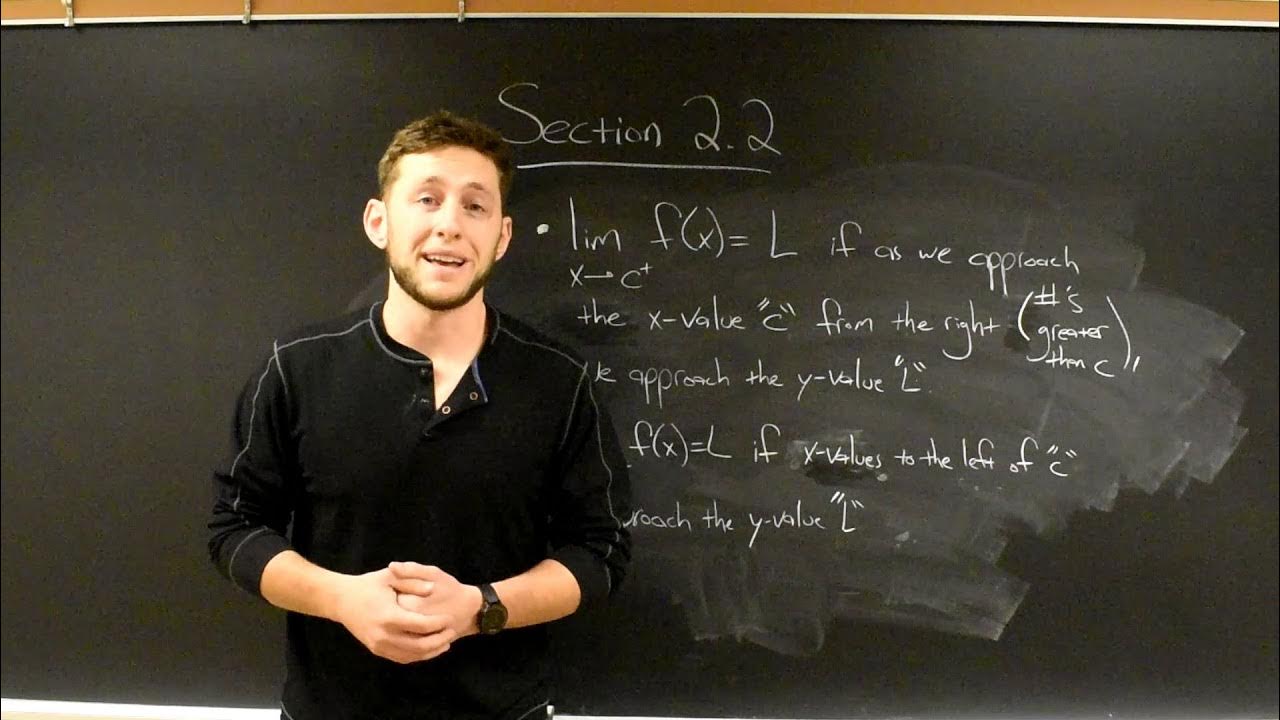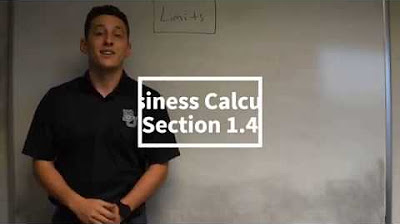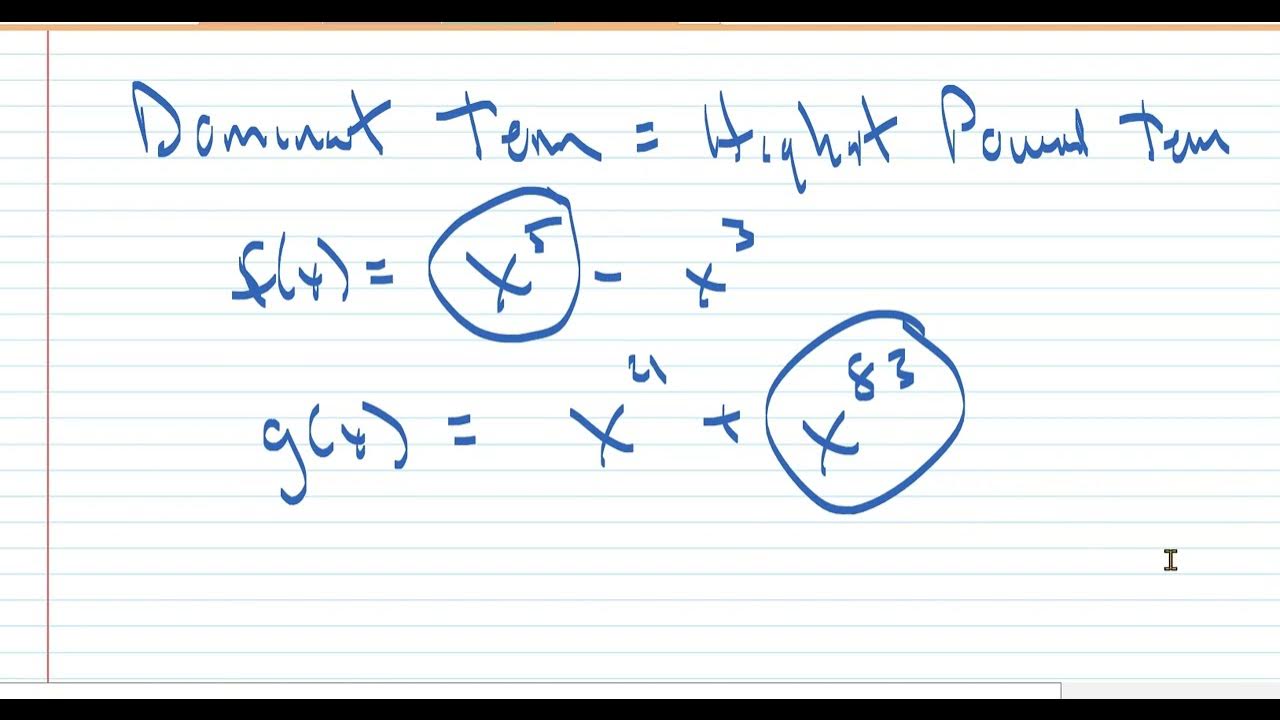1.1 - Numerical and Graphical Limits
TLDRThis video script delves into the fundamental concept of limits in calculus, which are essential for understanding the behavior of functions. The presenter explains that limits can be evaluated graphically, numerically, or algebraically, focusing on the first two methods. Through intuitive examples, such as imagining crossing a room in different ways, the script clarifies the idea of a limit as a value that a function approaches but may not necessarily reach. The video uses the example of a linear function to illustrate how to find limits both graphically and numerically, emphasizing the importance of considering both sides of the point in question. It also touches upon one-sided limits and the unique behavior of limits in rational functions, including asymptotic behavior. The script is a comprehensive introduction to limits, suitable for learners new to calculus, providing a solid foundation for further study in the field.
Takeaways
- 📚 The concept of a limit is fundamental to calculus and is used to understand the behavior of a function as its input approaches a particular value.
- 📈 Limits can be evaluated graphically, numerically, or algebraically, with this script focusing on the first two methods.
- 🚶♂️ An intuitive understanding of limits can be gained by imagining traversing a room in different ways, such as in steps that halve the remaining distance each time.
- 🏠 By considering an infinitely small point moving across a room, we can conceptualize never actually reaching a wall while getting infinitely close to it, illustrating the concept of a limit approaching zero.
- 🔢 In the context of functions, limits are analyzed by observing how output values (y-values) behave as input values (x-values) approach a specific number.
- 📉 For a linear function like f(x) = 2x + 3, the limit as x approaches a certain value can be found by looking at the function's graph and table of values.
- 🔑 The limit of a function at a point exists if the left-hand and right-hand limits agree and are equal to the function's value at that point, if it exists.
- 🔍 Numerically evaluating a limit involves looking at the function's output for input values that are increasingly close to the point of interest.
- 🚫 A function's value at a point does not necessarily provide information about the limit at that point, especially if the function is not defined (has a hole) at that point.
- ∞ When dealing with rational functions, limits can involve infinity, either as x approaches infinity or as the function values approach infinity due to vertical or horizontal asymptotes.
- ➡️ The behavior of function values as x approaches positive or negative infinity can also be determined using limits, which can approach a finite value or infinity.
Q & A
What is the fundamental concept of a limit in calculus?
-The fundamental concept of a limit is the behavior of function values (outputs) as the input values approach a certain number. It represents how close the function values get to a specific value without necessarily reaching it.
How can limits be evaluated?
-Limits can be evaluated graphically, numerically, or algebraically. The method chosen depends on the function and the context in which the limit is being analyzed.
What is a one-sided limit and how is it represented notationally?
-A one-sided limit is when we consider the behavior of a function as the input values approach a certain number from only one direction, either from the left (negative side) or from the right (positive side). It is represented with a superscript negative sign (-) for the left-hand limit and a superscript positive sign (+) for the right-hand limit next to the number being approached.
Why can't we directly substitute a value into a function to find a limit if the function is undefined at that point?
-If the function is undefined at a certain point, directly substituting that point into the function would not yield a valid output. Instead, we must analyze the behavior of the function from both sides of the point in question to determine the limit.
What is a vertical asymptote and how does it relate to limits?
-A vertical asymptote is a vertical line on the graph of a function where the function is undefined, often because the denominator of a fraction is zero. It represents a boundary that the function cannot cross. When evaluating limits, we consider the behavior of the function as it approaches a vertical asymptote from both sides.
What is a horizontal asymptote and how does it affect the behavior of function values as x approaches infinity?
-A horizontal asymptote is a horizontal line on the graph of a function that indicates the value towards which the function values approach as x becomes very large or very small (approaches infinity or negative infinity). It provides an upper or lower bound for the function values.
How does the concept of a limit help in understanding piecewise functions?
-The concept of a limit is crucial for understanding piecewise functions because it allows us to analyze the behavior of the function at the points where the function's rules change. Limits can help determine if the function has a limit at these points and what that limit is, even if the function value itself is not defined at that point.
What is the limit of a function as x approaches a certain value if the function is continuous at that point?
-If a function is continuous at a certain point, the limit of the function as x approaches that value is equal to the function value at that point. There is no gap or hole in the graph, and the function values approach the same value from both sides.
How can you determine if a limit does not exist for a particular function at a certain point?
-A limit does not exist at a certain point if the left-hand limit and the right-hand limit are not equal. This means the function values approach different values from the left and right sides of the point in question.
What is the significance of infinity in the context of limits and how is it used?
-Infinity is used in limits to describe a situation where function values or input values become very large without bound. It is a concept that helps describe the behavior of a function as it approaches a vertical asymptote or as the input values go to positive or negative infinity.
What happens to the function values as x approaches a point where there is a hole in the graph?
-As x approaches a point where there is a hole in the graph, the function values may approach a specific value from both sides of the hole, indicating a limit exists. However, the function value at the point of the hole is undefined, and the hole represents a discontinuity in the function.
Outlines
🚀 Introduction to Limits in Calculus
The video begins by emphasizing the fundamental role of limits in calculus. It introduces three methods to evaluate limits: graphically, numerically, and algebraically, with a focus on the first two. The concept of a limit is illustrated through the analogy of crossing a room in two different ways, highlighting the intuitive idea of getting infinitely close to a value without necessarily reaching it.
📐 Understanding Limits through Graphical and Numerical Examples
The video uses a graphical example of a room-crossing scenario to explain the concept of a limit, where a point-sized entity approaches a wall by repeatedly halving the distance. It then shifts to a numerical perspective, using the function f(x) = 2x + 3 to demonstrate how y-values change as x-values approach a specific number, illustrating the limit as x approaches 2.
🔍 Analyzing Limits with a Focus on Function Behavior
The video delves into the behavior of functions as inputs (x-values) approach specific numbers. It explains that if corresponding y-values approach a certain number from both sides, this number is the limit of the function. A linear function, f(x) = 2x + 3, is used again to show how to find the limit as x approaches 2 both graphically and numerically.
📉 Examining One-Sided Limits and the Uniqueness of Limits
The video discusses one-sided limits, which only consider the behavior of a function as x approaches a certain value from either the left or the right. It is highlighted that for a general limit to exist, both the left-hand and right-hand limits must be the same. The concept of a limit is shown to be unique for a given function and approach direction.
🔢 Numerical Evaluation of Limits Using a Calculator
The video demonstrates how to use a calculator to evaluate limits numerically. It shows how to input a function into the calculator and adjust the table settings to generate x-values that approach a specific number. The example of the function f(x) = 2x + 3 is used to illustrate how y-values approach the limit as x-values get closer to 2.
🔍 Further Exploration of Limits in Functions
The video continues to explore limits by examining a rational function g(x) = (x^2 - 1) / (x - 1) and its behavior as x approaches 1. It shows that the function has a hole at x = 1, and despite this, a limit can be determined by looking at the behavior from the left and right, which in this case is 2.
📈 Limits and the Concept of Infinity in Functions
The video discusses how limits can help understand the behavior of functions as x approaches infinity or negative infinity. It uses the function f(x) = 1 / (x - 2) to illustrate how y-values approach infinity as x-values approach 2 from both sides, indicating a vertical asymptote. The concept of horizontal asymptotes is also introduced.
🔁 Behavior of Functions at Vertical Asymptotes
The video provides examples of how to determine the behavior of functions as they approach vertical asymptotes. It shows that different sides of the asymptote can lead to the function values approaching different infinities, and hence, the general limit does not exist in such cases.
🔄 Shifting Asymptotes and Evaluating Limits
The video concludes with an example of a function h(x) = 1 / (x - 2) + 3, which has a horizontal asymptote at y = 3 and a vertical asymptote at x = 2. It demonstrates how to evaluate limits as x approaches specific values, including the points where the function has asymptotes, and how to verify these with both graphical and numerical methods.
Mindmap
Keywords
💡Limit
💡Graphical Evaluation
💡Numerical Evaluation
💡Asymptote
💡Continuous Function
💡Piecewise Function
💡One-Sided Limit
💡Undefined Function Value
💡Rational Function
💡Infinity
💡Horizontal Asymptote
Highlights
Introduction to the concept of limits, fundamental to calculus.
Three ways to evaluate a limit: graphically, numerically, and algebraically.
Definition of a limit and its intuitive understanding through examples.
Graphical and numerical evaluation of limits demonstrated through examples.
Explanation of how limits can represent values that are approached but not necessarily reached.
Use of a function's behavior as inputs change to understand limits.
Analyzing function values as x values approach a specific number from both sides.
Graphical representation of a function to determine the behavior of y values as x approaches a certain value.
Numerical method to evaluate limits by inputting x values close to the point of interest.
Explanation of one-sided limits and their importance in understanding function behavior.
Formal definition and notation for limits in calculus.
Illustration of how to determine if a limit exists by comparing left-hand and right-hand limits.
Use of graphing calculator to find function values and analyze limits.
Investigation of limits for piecewise functions and rational functions.
Analysis of asymptotic behavior in rational functions and how limits help understand them.
Determination of limits as x approaches infinity and negative infinity for specific functions.
Shifting of graphs and asymptotes due to modifications in function expressions.
Verification of limit values using both graphical and numerical methods.
Transcripts
5.0 / 5 (0 votes)
Thanks for rating:





